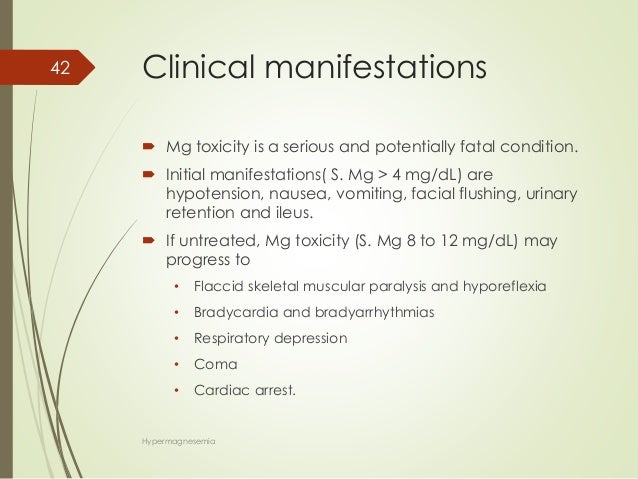

Therapeutic levels are reached almost immediately with appropriate intravenous doses and within 60 minutes following intramuscular injection. Magnesium sulfate heptahydrate 1 g = 98.6 mg or 8.1 mEq or approximately 4 mmol magnesium (Mg 2+).

Magnesium Sulfate 50% w/v solution may be administered by intravenous or intramuscular routes (see Method of administration below). Date of first authorisation/renewal of the authorisation

Continuous cardiac monitoring and pulse oximetry should be established an ECG should be performed.Succinylcholine should be avoided because it is degraded by AChE and may result in prolonged paralysis. Immediate aggressive use of atropine may eliminate the need for intubation. Intubation may be necessary in cases of respiratory distress due to laryngospasm, bronchospasm, bronchorrhea, or seizures. Airway control and adequate oxygenation.Gently cleanse with soap and water to hydrolyze organophosphate solutions. Termination of the exposure including removing all soiled clothing.Severe reactions can lead to ventilatory failure and death (cholinergic crisis). Skeletal muscle initially exhibits fasciculation (involuntary irregular, violent muscle contractions) followed by the inability to repolarize cell membranes resulting in weakness and paralysis. (SLUDGE) salivation, lacrimation, urination, diaphoresis, gastrointestinal upset, emesis and progressing to bronchospasm, bronchorrhea, blurred vision, bradycardia or tachycardia, hypotension, confusion, and shock. Since acetylcholinesterase is the enzyme that degrades acetylcholine following stimulation of a nerve, by inhibiting acetylcholinesterase, organophosphates allows acetylcholine to accumulate and result in initial excessive stimulation followed by depression. Acetylcholine is the neurohumoral mediator at the cholinergic junctions.Occurs at cholinergic junctions of the nervous system including postganglionic parasympathetic junctions (sites of muscarinic activity), autonomic ganglia and the neuromuscular junctions (sites of nicotinic activity) and certain synapses in the CNS.Acetylcholinesterase inhibitors that form a stable irreversible covalent bond to the enzyme.Organophosphates are also used in ophthalmology – echothiopate is used to treat glaucoma.
#Magnesium toxicity antidote skin
They can be rapidly absorbed through skin and mucous membranes or by inhalation. Organophosphate compounds are used as commercial insecticides (isulfoton, phorate, dimethoate, ciodrin, dichlorvos, dioxathion, ruelene, carbophenothion, supona, TEPP, EPN, HETP, parathion, malathion, ronnel, coumaphos, diazinon, trichlorfon, paraoxon, potasan, dimefox, mipafox, schradan, sevin, and dimetonor) in chemical warfare (nerve gases such as tabun and sarin) and are applied as aerosols or dusts.


 0 kommentar(er)
0 kommentar(er)
